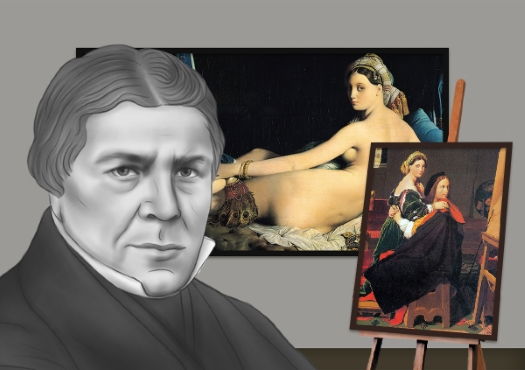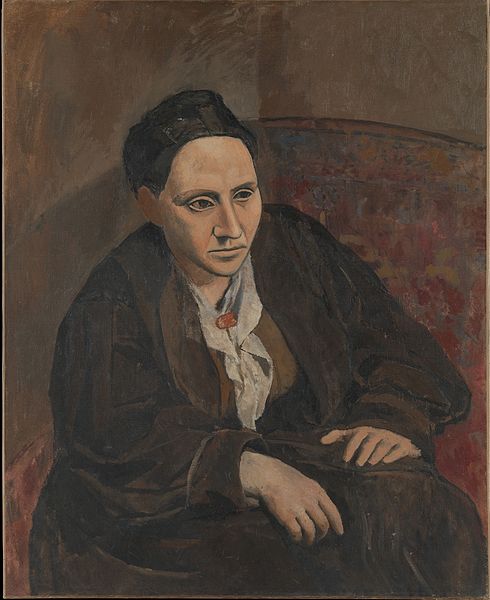Summary of Jean-Auguste-Dominique Ingres
With a daring blend of traditional technique and experimental sensuality, Jean-Auguste-Dominique Ingres reimagined Classical and Renaissance sources for 19th century tastes. A talented draftsman known for his serpentine line and impeccably rendered, illusionistic textures, he was at the center of a revived version of the ancient debate: is line or color the most important element of painting? Yet Ingres was not always successful; his experiments with abstracting the body and introducing more exotic and emotionally complex subjects earned harsh criticism in his early career. In truth, his work is best understood as a hybrid between Neoclassicism and Romanticism. It was only as the foil to the more dramatic Romanticism of Eugène Delacroix that Ingres came to be widely accepted as the defender of traditional painting and classicism.
Accomplishments
- One of the most talented students in the studio of Jacques Louis David, Ingres found early success, winning the coveted Prix de Rome on only his second attempt. Yet while Ingres would always reflect the classical style associated with David, he complicated his master's legacy by distorting his figures and in choosing narratives that broke with the moral exemplars of his teacher.
- In pursuit of more beautiful forms and harmonious line, Ingres pushed the abstraction of the body beyond the idealism of the Neoclassical. He abstracted his figures, even departing from the plausible construction of the body, to emphasize graceful contours and a pleasant visual effect. This new level of freedom would encourage other artists to take liberties with the human form, from Renoir (who was reportedly infatuated with Ingres) to the 20th century Surrealists.
- Despite his transgressions, when compared to the painterly brushwork and brilliant palettes of the Romantics, such as Eugène Delacroix, Ingres was undoubtedly connected to the classical tradition and academic style. In the mid-19th century, he came to represent the Poussinistes, who believed that the cerebral quality of the drawn line was more critical to a painting, opposed to the Rubenistes, who favored the emotional impact of color. As the defender of tradition, Ingres updated Renaissance ideals for the modern era, in particular working after the model of Raphael.
Important Art by Jean-Auguste-Dominique Ingres
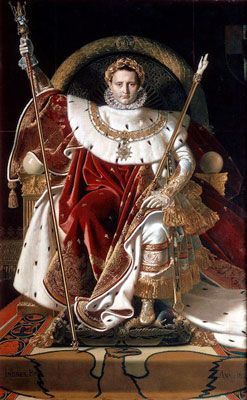
Napoléon on his Imperial Throne
Perhaps now the most iconic portrait of Emperor Napoléon I, Ingres's painting was originally dismissed as overly gothic, archaic, and even "barbaric." Opulently adorned, the newly crowned emperor is represented among a hodgepodge of Roman, Byzantine, and Carolingian symbols. The intention, to legitimize his claim to authority, is overshadowed by the strangeness of this imposing frontality; his pallid face emerges from layers of ostentatiously regal garb to look past the viewer with a stony gaze.
Ingres's painting was inspired by art historical depictions of power; it was a strategy similarly employed by Napoleon himself, who often used symbolism associated with the Roman and Holy Roman empires to reinforce his rule. Pictorially, Ingres looks directly to the God the Father panel from Jan van Eyck's Ghent Altarpiece (looted during the Napoleonic Wars, this altarpiece was part of the new Musée Napoléon); replacing God with Napoleon, encircled by the golden laurel wreath and throne, Ingres suggests his sitter's power, even divinity. This pose also recalled the legendary statue of Zeus at Olympia by the ancient Greek sculptor Phidias. Although that statue had been lost in antiquity, the Neoclassical interest in such relics made it a newly relevant and recognizable reference for the 19th-century viewer.
Coupled with these art historical references, the presentation of Napoleon's body and accessories underscores his power. Indeed, Ingres uses every inch of the considerable, nearly 9' tall, canvas to project Napoléon's political and martial prowess, assembling an eclectic yet legible iconography: Napoléon's robes are of rich purple, a color long associated with royalty and the Roman empire; a heraldic shield bearing the crest of the Papal states can be seen above his left shoulder, a reference to his position as King of Italy; his Legion of Honor medal rests on a lavish ermine collar; and the hand of justice sits atop a rod that crosses subtly with a bejeweled sword (modeled after the sword of Charlemagne, a ruler that the emperor sought to emulate), representing a balance of fairness and might. Most pointedly, Napoléon grasps a scepter in his right hand topped with a statuette of Charlemagne who holds the fleur-de-lis (associated with the royal Bourbon family) and the Imperial orb. This scepter, believed to have belonged to Charles IV, positions Napoleon as the successor to the French royal family as well as the historical line of Emperors.
Despite these art historical precedents, Ingres's portrait was soundly criticized at the Salon of 1806; it was even dismissed as "unintelligible" by his own teacher, Jacques-Louis David. As the Neoclassical style began to ebb, with tastes preferring a more natural and contemporary representation of power, Ingres's complex compendium of historical motifs seemed retrograde and outdated. Even though it was the target of scorn, with this complicated web of iconography and symbolism, Ingres ushered in a new twist on the Neoclassical and demonstrated his interests in art historical references and stylistic experiments.
Oil on canvas - Musée de l'Armée, Paris
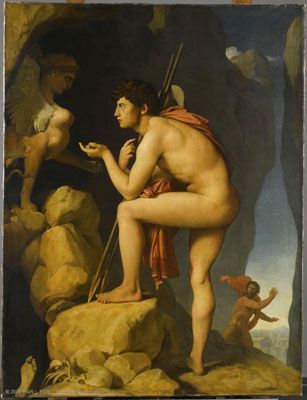
Oedipus and the Sphinx
Determined to prove his talent, the young Ingres dedicated himself to history painting, the most respected genre at the Académie. True to his neoclassical training, Ingres selected his subject from Greek mythology, but his choice of subject departs from the stoic heroes of David. Here we see the tragic hero Oedipus confronted with the riddle of the Sphinx. The dire threat he faces is suggested by the ominous pile of human remains, compounded by Oedipus's companion, shown fleeing in terror in the background. Although the painting still centers on the classical male nude, the narrative is more complicated than David's moral universe and suggests a step towards the complicated psychologies of Romanticism. Oedipus's correct answer will allow him to escape death and continue on the road to Thebes, yet his destiny is doomed.
When Ingres sent the painting to Paris as part of his first envoi de Rome, a typical practice for winners of the Prix de Rome, it received lukewarm feedback; critics claimed that the contours were not strong enough, the lighting was lackluster and the relationship between the figures was not sufficiently articulated. Ingres addressed these remarks later in his career when he returned to the canvas in the mid-1820s and enlarged it on three sides. What resulted is a highly engaging image that demonstrates his knowledge of the canon as well as his command of the nude male, a staple in the neoclassical Académie.
Oedipus's calm composure and commanding pose projects the themes of the tale that were closely tied to post-Revolutionary France: the predominance of human intelligence and its role in successful civilizations. And yet, Ingres does not shy away from the darker side of the story; the dramatic chiaroscuro, created by an upward-facing light (a lesson learned from studying the work of Guercino in Rome), lends the painting an ominous overtone. It subtly foreshadows Oedipus's tragic fate, namely, his marriage to his mother Jocasta and eventual death. Sigmund Freud, who would re-popularize the Greek myth in his formulation of the Oedipus Complex, owned a print after Ingres's painting, which hung near the couch in his consulting room.
Oil on canvas - Musée du Louvre, Paris
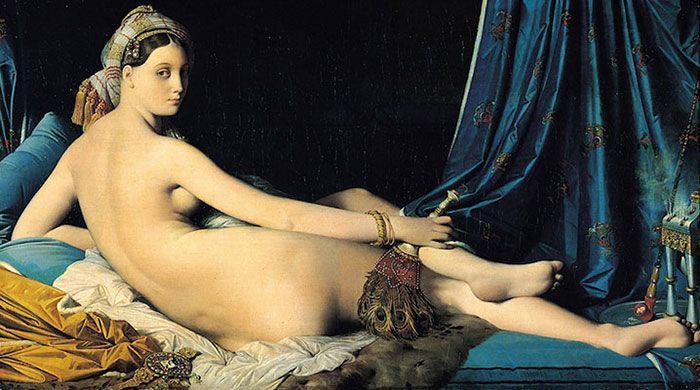
La Grande Odalisque
Within the long tradition of the female nude, Ingres's version demonstrates both his academic training and his penchant for experimentation. Indeed, the depiction of the idealized nude extends back to classical depictions of Aphrodite in ancient Greece. The reclining woman had been a popular motif since the Renaissance; Titian's Venus of Urbino was certainly an important example for Ingres. Here, Ingres continues this tradition by drawing the figure in a series of sinuous lines that emphasize the soft curves of her body, as well as by situating the woman in a lavish space, adorned with lustrous fabrics and intricately detailed jewels. Though he renders the body with the sculptural surface and clean lines associated with Neoclassicism, Ingres's painting also broke the expectations of pictorial illusionism by distorting the body beyond the plausible. Ingres has taken David's directive to idealize the human form to an extreme, so much that he was admonished by critics when he exhibited this painting at the Salon of 1819. The woman would need two or three extra vertebrae to achieve such a dramatic, twisted pose. So too do the figure's legs seem out of proportion, the left improbably elongated and disjointed at the hip. The result is paradoxical: she is at once strikingly beautiful and eerily strange.
For the sake of propriety, respectable depictions of the female nude had always been removed from the everyday by labeling them Venus, Diana, Suzannah, or some similar mythological or religious narrative that justified their nakedness. Further distancing Ingres from his Neoclassical roots, La Grande Odalisque's setting creates that necessary difference, not by referring to the ancient past, but through Orientalism. During Napoleon's empire, France consolidated its colonial possessions, beginning a highly politicized and problematic fascination with "the other." Ingres's odalisque, a term that refers to a concubine in a harem, is festooned with the trappings of what was then considered "the Orient," namely, Turkey and the Near East. Her peacock feather fan and bejeweled turban, as well as the delicate hookah pipe at far right, are markers of exoticism that allow for her nudity without offending the viewer (this painting was commissioned by Caroline Murat, Queen of Naples and sister to the Emperor Napoleon). To compare, when Édouard Manet painted his 1863 Olympia as a modern, French nude woman who gazed directly at the viewer, it was considered an immoral outrage.
Ingres's ability to merge elements of Neoclassical linearity and Romantic sensuality, resisting an easy categorization, provided a model for future avant-gardes. This particular painting has also become a flashpoint for discussions on the male gaze and the female subject, often appropriated by 20th-century artists as a means of art historical and institutional critique. The Guerrilla Girls, a group of anonymous women artists, transposed a gorilla head onto the body of the Odalisque for their poster Do Women Have To Be Naked to Get into the Met Museum? (1989), exposing the sexism and erasure of women in the contemporary art world by declaring, "Less than 5% of the artists in the Modern Art Sections are women, but 85% of the nudes are female." The group recreated the piece in 2011 with an equally damning set of statistics, again using Ingres's nude by way of illustration.
Oil on canvas - Musée du Louvre, Paris
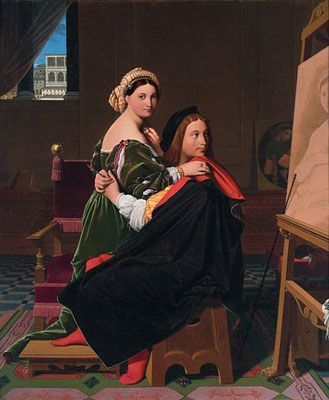
La Fornarina
Originally conceived as part of a series of paintings documenting the life of Ingres's idol, Raphael, La Fornarina shows the Renaissance master in the arms of his alleged mistress. Although Ingres ultimately abandoned the project, he painted five or six versions of this scene. It allowed him to showcase both his adoration for Raphael and demonstrate his mastery of the precise and illusionistic style.
Frequently quoting from the oeuvre of Raphael, Ingres positioned himself as the modern-day descendent of the revered painter. In this work, he gives the viewer an intimate insight into the personal and professional life of his idol. We are situated in Raphael's studio, his latest canvas barely begun on the easel before him. Yet, Raphael's model, la Fornarina (the baker's daughter) has risen from her pose to embrace the artist. Raphael is still engrossed in his work: he holds a paintbrush in his hand, his gaze firmly fixed on his painting. On the other hand, his model looks out to the viewer. The focus, and possibly the sacrifices, of the artist is the underlying moral to this painting - Raphael (and maybe Ingres as well) must not abandon the high calling of art to pursue the pleasures of love and leisure.
The attention of these two main figures is further complicated by the painted figures: Raphael's sketch and the Madonna of the Chair, visible in the background. Both are based on La Fornarina, and all three women stare at the viewer as reality and art are brought together. Of course, in Ingres's painting, all the figures are fictitious, but the point is made: for Raphael, and by extension, for Ingres, there is a seamless flow between art and life. That Ingres's own wife posed as the model for La Fornarina further emphasizes this connection between the artists.
Oil on canvas - Harvard Art Museums/Fogg Museum, Cambridge, MA
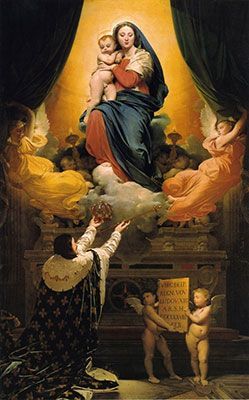
The Vow of Louis XIII
When Ingres left Paris for Italy in 1806, he swore that he would not come back until he was acknowledged as a serious and important history painter. This 1824 altarpiece allowed his triumphant return, as this hometown commission for the Montauban Cathedral was highly celebrated. The monumental painting, which measures nearly 14 feet high, was a challenging subject that brought together historical and religious iconographies and spaces. The scene commemorates an iconic moment from the reign of King Louis XIII from 1638, when he pledged the dedication of France to the Virgin Mary. This act, which had been celebrated as an annual holiday prior to the Revolution of 1789, had recently been reinstated under the Restoration period, which returned the Bourbon kings to the French throne. It was, therefore, a historical episode with very specific contemporary meaning, promising a divine benevolence and reinforcing the absolutist claim to rule. The Vow of Louis XIII demonstrates Ingres's ability to meld the historical and the contemporary, translating the classical scene into the simplified visual vocabulary of the 19th century.
The narrative required Ingres to carefully balance the composition between the earthly realm of Louis XIII and the heavenly sphere above. Ingres created two different atmospheres to distinguish between the spaces, bathing the Virgin Mary in a warm, idealized glow and emphasizing the materiality and textures of Louis XIII in a more concrete fashion. Again, Ingres drew heavily from art historical precedents, closely modeling his Virgin on Raphael's Sistine Madonna. The comparison was successful and positioned Ingres as the modern-day descendant of the Renaissance tradition, an important distinction as 1824 also marked the rise of Romanticism.
Before the painting's installation in Montauban Cathedral, it was exhibited at the Salon of 1824, an early battleground between the traditions of Neoclassicism and the emerging challenges of Romanticism. Compared to the expressive colors and contemporary subject of Eugène Delacroix's Scenes from the Massacres at Scio (1824), which were perceived as troublingly revolutionary (even incendiary), Ingres's Vow was seen as a bastion of tradition. Thus, despite the mixed reception of Ingres's earlier works and his departures from the Neoclassical, Ingres became the great defender of the classical tradition, a reputation that would follow him throughout his career. The year after this success, Ingres was awarded the Legion of Honor and elected to membership in the Academy, securing his reputation.
Oil on canvas - Montauban Cathedral
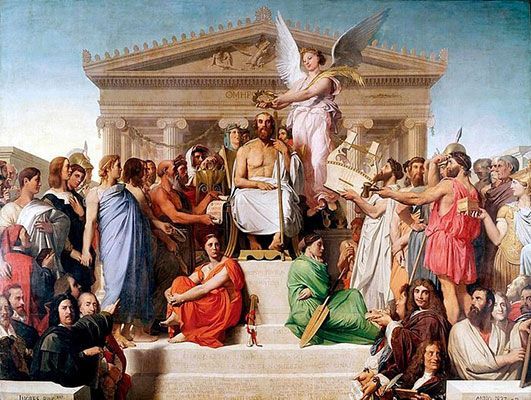
The Apotheosis of Homer
As the newly crowned defender of the academic tradition, Ingres was commissioned to decorate a ceiling in the Louvre to coincide with the opening of the Musée Charles X. This museum intended to demonstrate the cultural superiority of France and thereby reinforce the legitimacy of its monarch. Critical to this endeavor was the establishment of a continuum that stretched from the ancient world to modern-day France, and thus Ingres's Apotheosis of Homer became a project of political and cultural legitimization. Its pantheon of Western culture celebrates the lineage of classical thinkers and draws heavily from Raphael's School of Athens (1509-1511) from the papal apartments in Rome.
Where Raphael's work centered around a dialogue between Plato and Aristotle, Ingres's cultural celebration honors Homer as the originator of Western civilization. He sits in the center of the composition, crowned with a laurel wreath by Nike, the goddess of victory, and flanked by personifications of his two masterpieces, The Iliad (at left, a sword resting beside her) and The Odyssey (at right, an oar resting against her leg). Homer is surrounded by over 40 figures from the Western canon, including the Greek sculptor Phidias (holding a mallet), the great philosophers Socrates and Plato (turned toward each other in dialogue to the left of Phidias), Alexander the Great (at far right in golden armor), among others. Ingres also includes figures from more recent centuries; below Alexander the Great sits Michelangelo, drawing board in hand. William Shakespeare stands beside the painter Nicolas Poussin at bottom left, joined by Mozart and the poet Dantë. Ingres's hero and inspiration, Raphael is dressed in a dark tunic joining hands with the Greek painter Apelles and between them, a mostly obscured figure with a youthful face is allegedly a portrait of the young Ingres himself.
Whether or not this is a self-portrait, Ingres has clearly defined his cultural ancestry and affirmed the superiority of classical values. Art historian Andrew Carrington Shelton has labeled the Apotheosis a "highly personalized aesthetic manifesto." Not only did this support the reign of his patron, Charles X, but it also strengthened Ingres's claim as the modern representative of this tradition and its deep cultural significance. While some critics found the work to be formulaic and stiff, especially when compared to Delacroix's dynamic Death of Sardinapalus, shown in the 1827 Salon, it was also soundly defended by more politically and aesthetically conservative voices. Étienne Delécluze, a friend of Ingres and a highly regarded critic, upheld the Apotheosis as the expression of ideal beauty, directly comparing Ingres to the artists who are included in his painting. At a moment in culture when classical values were giving way to more bourgeois taste and politics - embodied by the revolutionary contemporaneity of Romantic painting - Ingres stakes his claim and aligns himself with the Académie and its heroes.
Oil on canvas - Musée du Louvre, Paris
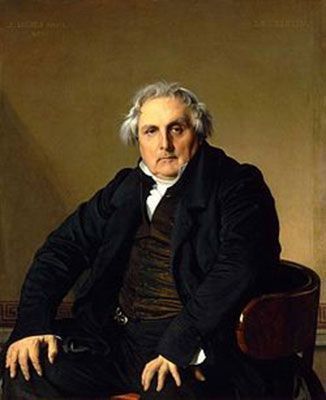
Portrait of Monsieur Bertin
There is a devil-may-care realism to this portrait, suggested by the informal grooming and slightly aggressive stance of the sitter. A somewhat gruff-looking older man, Monsieur Bertin sits hunched in a mahogany chair, legs splayed a bit indecorously; defying the protocols of formal portraiture, his jacket is crumpled and his waistcoat strains to contain his voluminous torso. There is little idealization, but rather a strong sense of character; Ingres seems to draw once again from the example of Raphael, recalling the Renaissance portrait of Baldessare Castiglione. Indeed, despite its informalities, Ingres's Portrait of Monsieur Bertin is anything but careless; meticulously drawn - one can practically count the strands of gray hair falling in tousled locks - and highly composed, the artist famously struggled to perfect the pose and demeanor of his sitter, producing many preparatory sketches in various configurations.
The seemingly casual pose, later emulated by Pablo Picasso in his portrait of Gertrude Stein (1905-06), broke from the traditional repertoire of portrait poses. There is a startling immediacy that was far ahead of its time; as one of Ingres's students, Louis Lacuria, wrote in a letter to a fellow painter, "Let me tell you that I was ruined, dumbfounded, shattered, when I saw the portrait of M. Bertin de Vaux, when I saw that full and complete obedience to nature, that absolute self-denial by the painter, that brush so completely mastered, I couldn't believe it." Apocryphally accidental and impromptu, this pose was "invented" by Ingres and his sitter and provides a clear sense of this bourgeois businessman and the modern tempo of his life.
The critical response to the painting at the Salon of 1833, however, was less impressed by Ingres's verisimilitude; instead, critics rejected this naturalism and the monotone palette. This restrained use of color and the austere background - a far cry from the opulence of his Napoléon on his Imperial Throne (1806) - was interpreted as sociopolitical commentary. Bertin, a journalist and ardent supporter of the July Monarchy, was an archetypal member of the ascending bourgeoisie. Ingres's portrait was disparaged as overtly opportunistic and self-congratulatory, and was widely received as representative of the new, bourgeois era. The painter Édouard Manet went so far as to describe Portrait of Monsieur Bertin as the "Buddha of the self-satisfied, well-to-do, triumphant bourgeoisie."
Oil on canvas - Musée du Louvre, Paris
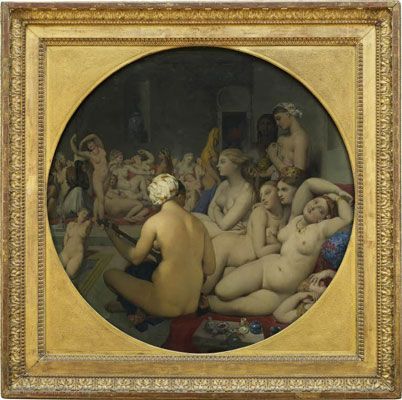
The Turkish Bath
The Turkish Bath both summarizes Ingres's treatment of the female nude and extends his legacy into the modern era. One of his most complex compositions, bodies seem to spill past the limits of the round canvas, the cramped spatial depth seems to multiply the plentiful flesh. Situating the viewer within an Orientalist interior, Ingres demonstrates his continued interest in colonialist themes. The open sensuality of the figures is striking, as their limbs intertwine to display an available, exotic eroticism.
Once more, Ingres brings together elements of the Neoclassical and the Romantic. His signature sinuous line verges on the fluidity of an arabesque, although he maintains the sculptural surface and precise rendering of his training. As with his earlier female nudes, Ingres takes artistic liberties when representing human anatomy - the limbs and torsos of the figures are distorted in order to achieve a more harmonious aesthetic - and yet they are painted with the undetectable brushwork of an academician.
Never having traveled to the Near East or Africa, Ingres was inspired by the letters of the 18th-century aristocrat Lady Mary Montague, copying her writings on the Ottoman Empire into his own notes. In one letter, Montague described the crowded bath at Adrianople: "naked women in various poses... some conversing, others at their work, others drinking coffee or tasting a sorbet, and many stretched out nonchalantly." Ingres translated the sense of languid relaxation in the supine bodies of his figures, adorned in turbans and the richly embroidered fabrics associated with the imagined Orient.
The sensuous nature of this expansive array of female flesh was too much for Ingres's patron. Commissioned by Prince Napoléon in 1852, it was initially displayed in the Palais Royal until the Princess Clotilde objected. The painting was returned to Ingres, who continued to modify it extensively until 1863. He finally decided to radically alter the traditional, rectangular format of the painting into a tondo, augmenting the sense of compression among the figures. Only in 1905 was the painting displayed publicly; even then, its debut at the Salon d'Automne was deemed revolutionary. Ingres was enthusiastically received by the emerging avant-garde as titillating and audacious in his treatment of flesh, abstraction of the body, and celebration of female sexuality. In particular, the young Pablo Picasso found it compelling, creating a series of works that recall the subject, including his Les Demoiselles d'Avignon (1907). Ingres's painting also inspired the many odalisques and female nudes of the Fauve artist Henri Matisse.
Oil on canvas mounted on wood - Musée du Louvre, Paris
Biography of Jean-Auguste-Dominique Ingres
Childhood
The eldest child of the sculptor, painter, and musician Jean-Marie-Joseph Ingres, Jean-Auguste-Dominique was born in 1780 in Montauban, a small town in southern France. Under his father's tutelage, he showed a talent for violin and a proclivity for drawing at a young age; his earliest-known signed drawing dates to 1789. His Parisian education at the Collège des Frères des Écoles Chrétiennes was cut short when the school closed during the French Revolution. In 1791, Ingres's father sent him to nearby Toulouse, enrolling him in the Académie Royale de Peinture, Sculpture et Architecture where he studied with the painters Guillaume-Joseph Roques and Jean Briant and the sculptor Jean-Pierre Vigan. He also continued his interest in music, performing second violin with the Orchestre du Capitole de Toulouse from 1794 to 1796. Ingres's musical abilities would later give birth to the phrase "Ingres's violin," used to describe a prodigious, but secondary talent, overshadowed by one's primary occupation; the term would later serve as the title for a famous 1924 Surrealist photograph by Man Ray.
Early Training
Following the typical progression for ambitious young artists, Ingres left Toulouse for Paris in August 1797; his father had secured him a place in the studio of the illustrious Neoclassical master, Jacques-Louis David. Here he would benefit from not only the instruction of David, but also the vibrant Parisian art world. The recent French military victories in Holland, Belgium, and Italy had brought to Paris trophies from historical art collections, providing Ingres with an unprecedented access to masterpieces of Renaissance art. His love of Raphael, in particular, was stoked by the presence of the Madonna della Sedia (c. 1512) from the Florentine Palazzo Pitti and the Vatican's Coronation of the Virgin (1502-04).
As David's pupil, he formed close relationships with his fellow students, notably Étienne Delécluze, later one of the foremost critics and defenders of Neoclassicism; he also befriended prominent former students such as Anne-Louis Girodet and Antoine-Jean Gros. This "School of David," adopted many precepts of their master, but also broke with his example; in particular, they began to favor more emotionally evocative and sensuous subjects, which encouraged a less rigid style of painting. According to Delécluze, Ingres tended to work in isolation, studiously concentrating on developing his own personal style. This penchant for resolute independence would follow him throughout his career, giving him a reputation for solitude and, later in life, even narrow-mindedness.
Ingres's early work demonstrates his mastery of academic convention, as well as his experimental breaks with that tradition; this combination brought his early success, his Ambassadors of Agamemnon (1801) was awarded the Prix de Rome. Political uncertainties and financial shortages, delayed his departure for Rome for five years. During this time, Ingres continued to work in Paris, quickly establishing his talent for portraiture. He submitted five portraits to Salon of 1806, including an early self-portrait, the Rivière family portraits, and, most notably, Napoléon I on his Imperial Throne (1806). It was only on the road to Rome that Ingres would learn of their lukewarm reception, with even his teacher David calling his Napoléon "unintelligible." Ingres decided that he would remain in Italy until he could return triumphant to Paris.
Mature Period
As the winner of the Prix de Rome, Ingres was expected to send work to Paris to demonstrate his progress; he was determined to excel in his contributions. Instead of merely sending back an academic male nude, his Oedipus and the Sphinx (1808) transformed that exercise into a history painting, the genre most celebrated by the Academy. Ingres also deliberately cultivated relationships with wealthy patrons, using his contacts at the Académie to gain commissions for both history paintings and portraits. While he felt portraiture was an unimportant use of his talent, it was profitable and necessitated by his 1813 marriage to Madeleine Chapelle. Indeed, it was only by virtue of his reputation as a portrait painter that Ingres survived the financial fallout of the Napoleonic Wars, ending in the Empire's collapse in 1814. While he was encouraged by the state's purchase of his Roger Freeing Angelica from the Salon of 1819, his other works were not so well received, and so he remained in Italy, moving to Florence in 1820.
Only weeks after his arrival in Florence, Ingres received the most important commission of his career. The French ministry of the interior requested a large-scale religious painting for the cathedral at Montauban, the artist's hometown, to memorialize the consecration of France by Louis XIII to the Virgin Mary in 1638. The result was The Vow of Louis XIII, completed in 1824 and received at that year's Salon as an unqualified success. The definitive turning point in Ingres's career, he became the chief defender of the classical tradition in opposition to the growing trend of Romanticism (represented at the same Salon by Eugène Delacroix's Scenes from the Massacres at Scio). Ingres's success at the Salon and his election to the Académie des Beaux-Arts as a corresponding member in 1823, allowed him to return to Paris in 1824 as a success after 18 years abroad. The following year, he received the Cross of the Legion of Honor from Charles X and another commission for a grand history painting on a ceiling at the Louvre, The Apotheosis of Homer (1827).
Despite this official recognition, Ingres occasionally stumbled. The Martyrdom at Saint Symphorian, completed in 1834 for the cathedral at Autun was poorly received at that year's Salon; critics disparaged its dark tonalities, disorderly composition, and the anatomical distortion of his figures. True to his temperamental reputation, Ingres swore that he would neither exhibit at the Salon nor accept government commissions ever again. Shuttering the doors to his Parisian studio, he sought the directorship of the Académie de France in Rome. After edging out fellow painter Horace Vernet by one vote, he returned to Rome in December 1834.
Late Period
Despite his dramatic exit from Paris, the still-ambitious Ingres was not entirely true to his word. Commissioned by Prince Ferdinand-Philippe, an esteemed collector and son of King Louis-Philippe, Antiochus and Stratonice (1840) was very well received in a private exhibition staged in the patron's residence. On the heels of this success, Ingres returned to Paris after his six-year term of heading the Académie in Rome in 1841, writing to a friend, "I am well vindicated. Although I have always been a modest and humble little boy before the Ancients, [...] I must admit it is very flattering to see tears flow in from my works, and by those with good and refined sensibilities.". As art historian Gary Tinterow explained, "Unlike the heroes he immortalized, Napoleon and Homer, Ingres organized and witnessed his own apotheosis."
Although he had vowed to never exhibit his work in public again, Ingres agreed to participate in in 1846 retrospective featuring Jacques-Louis David and his most formidable students. Ingres held a position of honor; after his master, he had the largest number of works on display and reviews focused on his portraits, calling him "our century's master without equal with regard to his portraits." Then, in 1855 he was honored with a monographic retrospective and a gallery devoted entirely to him at the Exposition Universelle. Despite this sign of respect, the ever-ornery and paranoid Ingres was outraged at having to share the grand medal of honor that year with nine other artists, including his rival, Delacroix, the anointed king of Romanticism and so-called "apostle of the ugly."
A particularly interesting episode on the rivalry between Ingres and Delacroix is highlighted by the author and art writer Julian Barnes in his book Keeping an Eye Open (2015). "[The 19th-century writer Maxime] Du Champ tells the story of a banker who, innocent of artistic politics, managed mistakenly to invite both painters to dinner on the same evening. After much glowering, Ingres could no longer restrain himself. Cup of coffee in hand, he accosted his rival by a mantelpice. 'Sir!' he declared, 'Drawing means honesty! Drawing means Honor!' Becoming ever-choleric in the face of the cool Delacroix, Ingres upset his coffee down his own shirt and waistcoat, then seized his hat and made for the door, where he turned and repeated, 'Yes, sir! it is honor! It is honesty!'"
In the last decade of his life, Ingres's practice became increasingly private, as he focused on producing works for his close friends and family. He was revered, Emperor Napoléon III even appointed him Senator in May 1862, yet his final working years were spent revisiting old motifs and long-abandoned canvases, including modified versions of The Apotheosis of Homer, Antiochus and Stratonice, and Oedipus and the Sphinx. His final recorded work, listed in a notebook as "a large Virgin with the Host and two angels" is dated December 31, 1866. Within two weeks, Ingres would be dead of pneumonia. He bequeathed the contents of his studio to (what later became) the Musée Ingres at Montauban.
The Legacy of Jean-Auguste-Dominique Ingres
Though closely associated with the Académie and its reputation for conservatism, Ingres's interest in linear beauty and his willingness to distort his subjects to achieve a more pleasing visual form have impacted the avant-garde. His multiple canvases of female harems and odalisques inspired other artists to take up the subject; Édouard Manet's Olympia (1863) would reinvent the odalisque as a Parisian prostitute (shocking Salon audiences) while Henri Matisse would emphasize the Orientalist exoticism of his reclining female nudes. Edgar Degas would look to Ingres as a master draftsman, emulating his linearity underneath his Impressionist brushstroke. Gustave Moreau embraced Ingres's academicism, extending the lessons of classical contours and narratives into the late-19th century. Pablo Picasso pushed Ingres's figural distortions to new levels, but also looked to his highly finished portraits as a model for his interwar classical style. Indeed, Cubism's insistence on art as an intellectual and cerebral undertaking has been connected directly to the Neoclassical example, which emphasized looking as a thoughtful, rather than emotional or sensational experience. The impeccable illusionism and abstracted bodies of Ingres's work create a sense of strangeness that would inspire the Symbolists and Surrealists with its combinations of the familiar and the peculiar.
In the 20th century, many artists have acknowledged the subtlety with which Ingres pushed the limits of academic style in his work, manipulating human anatomy and the norms of composition. Because Ingres willingly sacrificed illusionism in favor of aesthetic and compositional effects, Barnett Newman identified him as a predecessor of Abstract Expressionism, stating in an interview, "That guy was an abstract painter. [...] Kline, de Kooning - none of us would have existed without him." Other artists, including the Guerrilla Girls, have criticized Ingres as the chief representative of retrograde art-making practices that exploited the female nude to a male gaze and have taken issue with his eroticized, colonialist subjects.
Influences and Connections

-
![Raphael]() Raphael
Raphael -
![Jacques-Louis David]() Jacques-Louis David
Jacques-Louis David - Antoine-Jean Gros
- Anne-Louis Girodet
- Étienne Delécluze
-
![Edgar Degas]() Edgar Degas
Edgar Degas -
![William-Adolphe Bouguereau]() William-Adolphe Bouguereau
William-Adolphe Bouguereau -
![Pablo Picasso]() Pablo Picasso
Pablo Picasso - Théodore Chassériau
- Alexandre Cabanel
Useful Resources on Jean-Auguste-Dominique Ingres
- Ingres and His CriticsOur PickBy Andrew Carrington Shelton
- Ingres: Sa vie, ses travaux, sa doctrine, d'apres les notes manuscrites et les lettres du maitreOur PickBy Henri Delaborde
